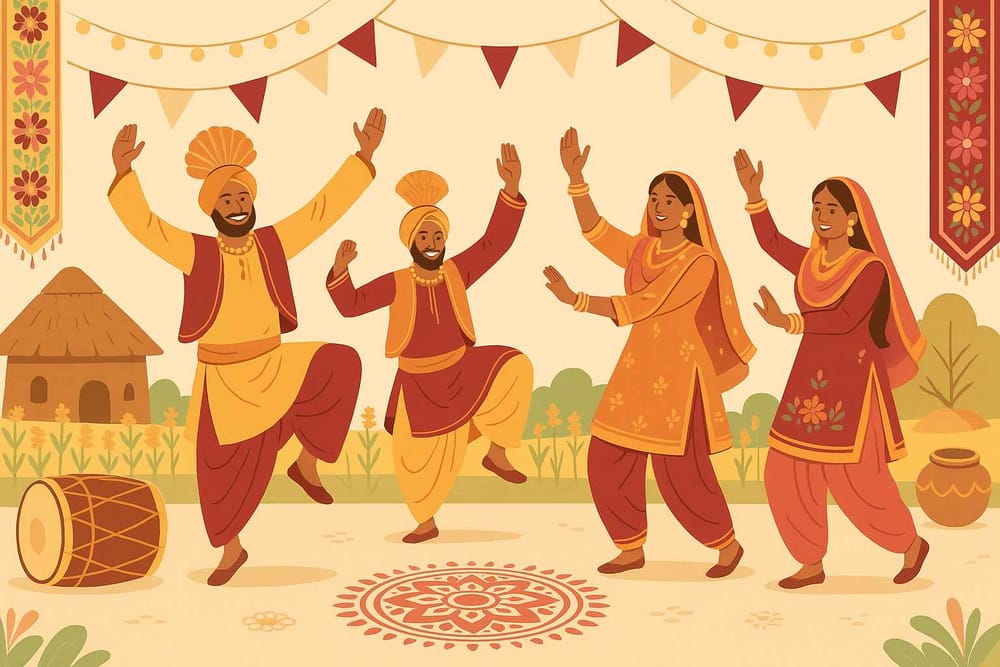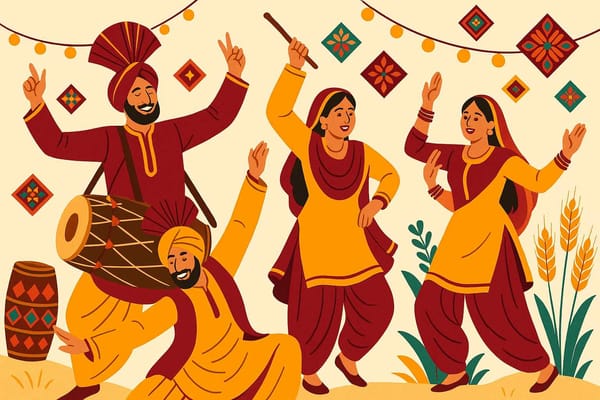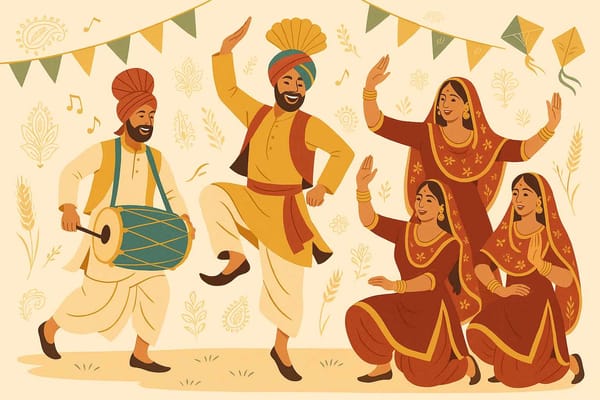
Folk Dances of Punjab - Celebrate Rich Culture
The moment you hear the deep, resonant beat of a dhol, something inside you stirs. It’s a call to joy, a rhythm that travels from your ears to your feet, making you want to move. This is the magic of Punjab, a land where every celebration, every season, and every emotion finds its voice in the form of dance. These folk dances are not just performances; they are the very heartbeat of Punjabi culture, a living, breathing storybook of its people's lives, struggles, and unshakeable spirit.
Born from the fertile soil of the land of five rivers, these traditions are as old as the fields of golden wheat that sway in the breeze. They began as simple expressions of gratitude after a bountiful harvest, a way for farmers to thank the earth during festivals like Baisakhi. Over centuries, they have woven themselves into the fabric of daily life, narrating tales of love, courage, and community.
Bhangra: The Roaring Pulse of Punjab
When you think of Punjabi dance, Bhangra is likely the first thing that comes to mind. It's an explosion of energy, a powerful and electrifying display of pure happiness. Originating from the Sialkot region, Bhangra was the farmer's dance of joy. The high jumps, the powerful kicks, and the coordinated movements were a physical expression of the success of their hard work.
The soul of Bhangra is the mighty dhol, a double-headed drum whose pulsating rhythm is simply infectious. Dressed in colourful kurtas, turbans, and traditional waistcoats, the dancers move with an energy that can light up any stage. Today, Bhangra has crossed oceans, becoming a global symbol of Punjabi pride and celebration, loved by people from all walks of life.
Giddha: A Celebration of Womanhood and Grace
If Bhangra is the thunder, then Giddha is the beautiful, life-giving rain. This graceful dance is the female counterpart to Bhangra and is a mesmerising celebration of feminine energy. Performed by women in a circle, Giddha is a beautiful blend of rhythmic clapping, elegant footwork, and expressive storytelling. It's more than just a dance; it’s a conversation.
The heart of Giddha lies in the folk couplets known as ‘Boliyan’. Through these songs, women share stories, express their daily joys and sorrows, and even engage in witty social commentary. Adorned in vibrant salwar kameez and heavy jewellery, their movements tell stories of weddings, births, and festivals, creating a powerful sense of sisterhood and community. The colourful attire of Giddha truly reflects the festive spirit, much like the traditional wear celebrated in other parts of India.
Exploring More Rhythms: Beyond Bhangra and Giddha
The landscape of Punjabi folk dance is rich and diverse. While Bhangra and Giddha take the spotlight, there are several other beautiful forms that deserve to be celebrated.
- Jhumar: Hailing from the Sandalbar region, Jhumar is a dance of pure grace and elegance. The movements are slower, more rhythmic, and often performed in a circle. It is a dance of emotion, typically celebrating themes of love and nature, with movements that mimic the gentle swaying of trees in the wind.
- Luddi: This is a dance of victory and celebration. Performed by men, Luddi involves energetic movements like finger-clicking, jumps, and half-turns. It is often seen at weddings and sporting events, where the dancers express their triumph and happiness with infectious enthusiasm.
- Sammi: A traditional dance performed by women, Sammi originates from the tribal belts of Punjab. It is a graceful and poignant dance that tells stories of longing and love. The performers, dressed in colourful kurtas and lehengas, use intricate footwork and hand gestures to convey deep emotions.
- Malwai Giddha: Don't be fooled by the name! This is an energetic folk dance performed by men from the Malwa region of Punjab. It’s a performance full of mimicry and folk poetry, where performers often use a variety of instruments like the Chimta and Dholaki to create a lively and entertaining spectacle.
- Kikli: As much a game as it is a dance, Kikli is a delightful sight. Performed by two young girls, they cross their arms, hold hands, and spin around in circles at high speed, singing folk songs. It is a beautiful representation of youthful joy, friendship, and innocence.
- Gatka: This is more than just a dance; it is a traditional Sikh martial art that is both a spiritual practice and a performance. Gatka combines combat techniques with rhythmic movements, showcasing incredible agility, discipline, and courage. It is a powerful display of the warrior spirit.
The Music: The Soul That Moves the Feet
No Punjabi folk dance is complete without its soul-stirring music. The dhol may be the king, but other instruments like the tumbi (a single-string instrument), algoza (a double flute), and chimta (tongs) add layers of melody and rhythm. The folk songs, or `boliyan`, are the narrative thread, telling stories that everyone can connect with.
This beautiful synergy of music, dance, and storytelling creates an atmosphere that is truly immersive. It is a testament to how heritage is kept alive through rhythm and performance, passed down from one generation to the next, not just as an art form but as a way of life.
Answering Your Curiosities About Punjabi Dance
Many people are curious about the rich traditions behind these dances. While we've talked about Bhangra and Giddha, the world of Punjabi folk dance is vast, including Jhumar, Sammi, Luddi, and Kikli, each with its own unique flavour and story. Bhangra is renowned for its explosive energy, traditionally performed by men to celebrate the harvest, while its counterpart, Giddha, is a beautiful expression of grace performed by women, rich with storytelling through song.
These dances are not reserved for the stage; they are deeply woven into the fabric of life's most important moments. Whether it's a wedding, a festival, or a simple get-together, these dances bring people together in a shared expression of joy. While anyone can learn and enjoy these dances, understanding their cultural roots and traditional steps adds a layer of authenticity and respect that truly honours their spirit.
Preserving Our Precious Heritage with Bhaktilipi
This deep connection between celebration, culture, and spirituality is something we cherish dearly at Bhaktilipi. We believe that understanding our traditions is the best way to keep them alive. Our mission is to preserve and share timeless devotional literature and cultural stories in a way that resonates with today’s world.
At Bhaktilipi.in, you can explore the rich tapestry of Indian culture, from the energetic dances of Punjab to the profound wisdom of ancient texts. We help you stay connected to your roots with authentic information, right at your fingertips.
Follow us on Facebook, Instagram, and YouTube for a daily dose of inspiration and knowledge. Let’s celebrate and preserve the vibrant spirit of our culture together, ensuring these timeless traditions continue to bring joy for generations to come.
A passionate group of people dedicated to preserving India's knowledge of Dharma, Karma, and Bhakti for ourselves and the world 🙏.
Comments
Related in

Vibrant Folk Dances of Punjab: A 2025 Cultural Journey
The very soul of Punjab beats to the rhythm of the dhol. It’s a sound that echoes through its lush green fields, a sound that calls people to gather, to celebrate, to feel alive. This isn't just music; it's the living, breathing essence of Punjabi

Folk Dances of Punjab: Weave the Cultural Tapestry
Have you ever felt a beat so powerful it seems to echo right in your soul? That’s the magic of Punjab for you. It’s a land where the earth itself seems to dance, where the joy of a good harvest, the celebration of a wedding, or simply the

The Vibrant Rhythms: Folk Dances Define Punjab
Can you hear it? That powerful, soul-stirring beat of the dhol that makes your feet want to tap and your heart want to soar. That, my friend, is the sound of Punjab. It’s a land where joy isn't just felt; it's danced. The folk dances
